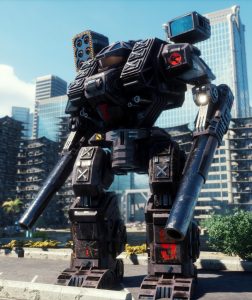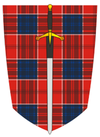Difference between revisions of "Mercenary"
(refs/biblio) |
LittleWolf (talk | contribs) |
||
| Line 1: | Line 1: | ||
| − | + | A '''Mercenary''' is a soldier for hire, a warrior who fights not for a particular cause or goal but for material gain. In the [[Inner Sphere]], private, contracted military units have been doing a lot of the fighting. Some are only in it for the cash, some for principle, but, whatever the reason, mercenary forces run the gamut from some the most disreputable to some the most elite troops available. Many mercenary companies do not survive their first battle, but dozens have gone on to become successful, trusted units that form key parts of their employers' defenses. | |
| − | In the [[Inner Sphere]], private, contracted military units have been doing a lot of the fighting. Some are only in it for the cash, some for principle, but, whatever the reason, mercenary forces run the gamut from some the most disreputable to some the most elite troops | ||
| − | == | + | ==History== |
| − | + | Mercenaries have played a role in the history of human warfare since the beginning, though there had been a general decline in their use towards end of the second millennium. That changed in the [[twenty-third century]] as interstellar exploration and the rise of neo-feudalism created a demand for trained soldiers to fight in what became known as the [[Age of War]]. The [[Reunification War]] and the formation of the [[Star League]] brought about an age of relative peace, again decreasing the demand for hired guns. Mercenaries were still valuable as deniable assets in the [[Hidden Wars]] between the [[Great Houses]], but there was little respect for the profession, with many units little more than "fly-by-night" operations.<ref>''Era Report: 2750'', p. 114</ref><ref name=MH7>''Mercenary's Handbook'', p. 7</ref><ref name=FMM7>''Field Manual: Mercenaries'', p. 7</ref> | |
| + | That all changed after the [[Amaris Civil War]]. Rather than try to reconstitute the League by force, [[Aleksandr Kerensky]] and nearly 80% of the surviving [[Star League Defense Force]] chose [[Operation Exodus|exile]] in [[2784]]. Of those SLDF units which remained behind, many hired themselves out to whichever Great House was willing to pay the most for their services. Those services were soon put to the test with the outbreak of the [[Succession Wars (History)|Succession Wars]].<ref name=MH7/><ref name=FMM7/> Shortly after it started, the newly-formed [[ComStar]] created the [[Mercenary Review Board]], a neutral arbitrator for both mercenaries and employers alike.<ref>''ComStar (sourcebook)'', p. 15</ref> | ||
| − | + | In their quest to seize the throne of the Star League during the Succession Wars, the Great Houses abandoned the [[Ares Conventions]] and committed murder on an unimaginable scale, rendering whole worlds lifeless and erasing centuries of technological progression. Ironically, it was mercenaries who played a role in trying to save humanity from itself, though not necessarily out of noble purpose. Seeking to protect their livelihood, many mercenaries began using their contracts to police their employers, refusing to take missions which violated the Ares Conventions. Mercenaries were responsible for reviving the tradition of offering opponents the chance to surrender and pay a "ransom" so they could return home. Eventually, all factions within the Inner Sphere and Periphery had adopted to one degree or another a code of conduct called the ''Honors of War''. Also known simply as the ''Conventions'', these guidelines were based on the Ares Conventions and mercenary practices which promoted fair dealing and limited warfare.<ref name=FMM8>''Field Manual: Mercenaries'', p. 8</ref><ref name=MH29>''Mercenary's Handbook'', p. 29</ref> And it was a mercenary unit, the [[Gray Death Legion]], which recovered the [[Helm Memory Core]] in [[3028]] and opened the door for the Inner Sphere to start recovering much of the [[lostech]] which had disappeared over centuries of constant fighting.<ref>''Technical Readout: 3039'', p. 222</ref> | |
| − | [[ | ||
| − | The | + | The [[Clan Invasion]] was as devastating to those mercenaries caught in its path as it was to the Great Houses which suddenly found themselves the target of the SLDF's descendents: of the 108 mercenary [[regiment]]s which faced the Clans in front-line combat, nearly a third were totally destroyed.<ref>''Field Manual: Mercenaries'', p. 26</ref> It also revealed the secret origin of [[Wolf's Dragoons]], one of the most celebrated mercenary units in history, as forward scouts for the invasion but who nevertheless chose to side with the Inner Sphere against their Clan brethren. Mercenaries like the Dragoons and [[Kell Hounds]] were instrumental in defeating the Clans during the [[Battle of Luthien (Clan Invasion)|Battle of Luthien]], and with trust in ComStar lost after the [[ComStar Schism]] the Dragoons helped to create the [[Mercenary Review and Bonding Commission]] to replace the MRB. Mercenaries played an important role in the destruction of [[Clan Smoke Jaguar]] and ending the Clan threat during [[Operation Bulldog|Operations Bulldog]] and [[Operation Serpent|Serpent]], and some went "legitimate" by helping to form a new [[Second Star League Defense Force|SLDF]].<ref name=FMM8/><ref name=FMMr7>''Field Manual: Mercenaries Revised'', p. 7</ref> In the years after, mercenaries continued to help defend against Clan incursions, but once again soon found themselves caught up in the power struggles of the Inner Sphere: mercenaries fought in the [[FedCom Civil War]], the [[Capellan-St. Ives War]], and operated in the [[Chaos March]] region, among other battlefronts.<ref>''Field Manual: Mercenaries Revised'', p. 8-9</ref> |
| − | + | ==Composition== | |
| + | Mercenary units come in all shapes and sizes, though for the most part conforming to standard [[Inner Sphere military structure]]. Most employ [[BattleMechs]], not least because these units get the most "bang for their buck" in terms of versatility and ability to accomplish a variety of missions, but others may instead employ other units like [[Combat Vehicle]]s or [[Infantry]]. However, few mercenary formations will utilize just a single unit type, as each has its own important role to play in the completion of the mission and the formation's survival. Even a single 'Mech [[Lance]] operating on its own can expect to employ a number of scouts necessary for performing reconnaissance or sabotage missions and support personnel to keep their machines working.<ref name=MH10>''Mercenary's Handbook'', p. 8-10</ref><ref name=FMM28>''Field Manual: Mercenaries'', p. 26-28</ref><ref name=FMMr32>''Field Manual: Mercenaries'', p. 30-32</ref> | ||
| − | + | Most successful 'Mech mercenary units employ a variety of different weight types and mission profiles in order to maximize their fighting potential. Depending on where they originated some units will feature designs associated with that region of space (i.e. a unit from the [[Free Worlds League]] might have more ''[[Trebuchet]]s'' than typical), but given the nomadic lifestyle and reliance of salvage this does not necessarily hold true. Most units lack the resources to buy the latest designs available to House forces, and with few exceptions don't have the technical knowledge to salvage Clantech, instead selling captured examples to the Great Houses in exchange for Inner Sphere equipment. Many will include a fair number of conventional assets attached to support the 'Mech forces, whether it's swift hovertanks spearheading an assault, VTOLs scouting the enemy's position, [[Jump Infantry]] performing anti-'Mech attacks or special forces operating deep behind enemy lines.<ref name=FMM28/><ref name=FMMr32/> Some units such as [[artillery]] and [[conventional fighter]]s are less common among mercenary units yet still find a place in many formations. Perhaps the most rare are [[Land-Air 'Mech]]s, with only the wealthiest able to maintain even a handful of such machines.<ref name=MH10/> | |
| − | + | Mercenaries make a point of securing their own transport, as to do otherwise either requires the expensive hiring of commercial shipping or reliance on the good graces of their employers. Many own their own [[DropShip]]s, preferably enough to carry the entire formation, allowing them to make planetary assaults and retreat from losing battles of their own volition. However, the rarity and expense of [[JumpShip]]s means only the most successful mercenaries are able to purchase one for their use. On the other hand, most mercenaries give a low priority to employing [[Aerospace Fighter]]s, generally seeing them as a poor return on their investment and more willing to rely on their employers to provide aerospace support, though even the most 'Mech-oriented mercenary commander will include some in her organization.<ref name=MH10/><ref name=FMM28/><ref name=FMMr32/> | |
| − | + | Perhaps the most important part of a mercenary formation are the support and administrative personnel which help keep it going: those commanders hoping for long-term success will recruit a technician as vigorously as they would a [[MechWarrior (pilot)|MechWarrior]]. Many mercenary formations cannot afford a support staff large enough to cover 100% of their needs, but will ensure a majority is kept in-house to avoid having to rely too heavily on expensive outside support.<ref name=FMM28/><ref name=FMMr32/> Ideally, each 'Mech or fighter will have its own technician assigned to maintain it, with assistant technicians to assist them (at least one Astech for every two Techs), but not every mercenary formation is so lucky.<ref>''Field Manual: Mercenaries'', p. 30</ref><ref>''Field Manual: Mercenaries Revised'', p. 35</ref> Mercenaries also try to maintain a ratio of one medical personnel for every twenty, though whether these are simple paramedics or full surgeons will depend on what they can afford.<ref name=FMM147>''Field Manual: Mercenaries'', p. 147</ref><ref name=FMMr150>''Field Manual: Mercenaries Revised'', p. 150</ref> Other important administrative positions include secretaries, accountants, and contract negotiators; smaller commands will often have officers or NCOs pull double-duty in these positions, but those which can afford their services benefit greatly from having a dedicated support staff.<ref name=FMM147/><ref name=FMMr150/> | |
| + | ==The Business of War== | ||
| + | {{sectionstub}} | ||
| + | |||
| + | |||
| + | ==List of Notable Mercenary Units== | ||
| + | Countless numbers of mercenary formations have come and gone over the centuries, but a few have made a notable mark and become famous (or infamous) for their exploits. For a full list of all known mercenary units, see [[:Category:Mercenary Commands|Mercenary Commands]]. | ||
| + | |||
| + | {|class="wikitable" width='700px' style="background: #gray; border: 2px solid black;" | ||
| + | ! colspan="6" align="center" style="border-bottom:2px solid black"| Eridani Light Horse | ||
| + | |- | ||
| + | |align="center "|[[Image:Eridani light horse.gif|center|100px]] | ||
| + | |One of the oldest and most prestigious mercenary commands, the [[Eridani Light Horse]] was originally part of the SLDF as the 3rd Regimental Combat Team. One of the few SLDF units to turn mercenary and maintain itself during the Succession Wars, the ELH was later instrumental in turning back the Clan threat and helping to reconstitute the second Star League. | ||
| + | |- | ||
| + | |} | ||
| + | {|class="wikitable" width='700px' style="background: #gray; border: 2px solid black;" | ||
| + | ! colspan="6" align="center" style="border-bottom:2px solid black"| Kell Hounds | ||
| + | |- | ||
| + | |align="center "|[[Image:Kellhounds.gif|center|100px]] | ||
| + | |The [[Kell Hounds]] have played a historic role in course of events since their founding in the early part of the [[31st century]]. They were one of the first Inner Sphere units to encounter the Clans, and from that meeting [[Phelan Kell]] joined [[Clan Wolf]]. They helped turn back the Clan Invasion, and in partnership with [[Clan Wolf-in-Exile]] created the [[Arc-Royal Defense Cordon]] to defend against further incursions. | ||
| + | |- | ||
| + | |} | ||
| + | {|class="wikitable" width='700px' style="background: #gray; border: 2px solid black;" | ||
| + | ! colspan="6" align="center" style="border-bottom:2px solid black"| Northwind Highlanders | ||
| + | |- | ||
| + | |align="center "|[[Image:NorthwindHighlanders.gif|center|100px]] | ||
| + | |The [[Northwind Highlanders]] were a mercenary unit under exclusive contract to [[House Liao]] until the [[Fourth Succession War]], when they sided with [[House Davion]] in return for their ancestral home of [[Northwind]]. They served the [[Federated Commonwealth]] in beating back the Clan threat, but eventually gained independence for themselves, joining with the [[Allied Mercenary Command]] in opposition to the [[Word of Blake]] | ||
| + | |- | ||
| + | |} | ||
| + | {|class="wikitable" width='700px' style="background: #gray; border: 2px solid black;" | ||
| + | ! colspan="6" align="center" style="border-bottom:2px solid black"| McCarron's Armored Cavalry | ||
| + | |- | ||
| + | |align="center "|[[Image:Mac.png|center|100px]] | ||
| + | |[[McCarron's Armored Cavalry]] was one of the largest and most successful mercenary units. Under exclusive contract with House Liao for much of its existence, the Big MAC went above and beyond in help to ensure the survival of its employer. The unit was eventually rewarded for its service by being formally incorporated into the [[CCAF]] and its soldiers made full citizens of the Confederation. | ||
| + | |- | ||
| + | |} | ||
| + | {|class="wikitable" width='700px' style="background: #gray; border: 2px solid black;" | ||
| + | ! colspan="6" align="center" style="border-bottom:2px solid black"| Gray Death Legion | ||
| + | |- | ||
| + | |align="center "|[[Image:Gdlblack.jpg|center|100px]] | ||
| + | |The [[Gray Death Legion]] was formed by [[Grayson Carlyle]] in the aftermath of his father's death. Against impossible odds the young Carlyle grew the Legion into a formidable fighting force, and was responsible for a technological renaissance with the recovery of the [[Helm Memory Core]]. The unit did not long outlive its founder, being destroyed in the [[FedCom Civil War]], though the survivors would found [[Gray Death Technologies]]. | ||
| + | |- | ||
| + | |} | ||
| + | {|class="wikitable" width='700px' style="background: #gray; border: 2px solid black;" | ||
| + | ! colspan="6" align="center" style="border-bottom:2px solid black"| Wolf's Dragoons | ||
| + | |- | ||
| + | |align="center "|[[Image:Wdragoons.gif|center|100px]] | ||
| + | |One of the most storied mercenary units in history, [[Wolf's Dragoons]] were secretly members of Clan Wolf sent to spy on the Inner Sphere in preparation for the Clan Invasion. However, the Dragoons would eventually decided to switch side and help the Inner Sphere, playing an instrumental role in defeating the Clan threat. From their homeworld of [[Outreach]] they created the MRBC and the Allied Mercenary Command to counter the threat posed by the Word of Blake. | ||
| + | |- | ||
| + | |} | ||
==References== | ==References== | ||
<references /> | <references /> | ||
| − | |||
==Bibliography== | ==Bibliography== | ||
| − | + | *''[[ComStar (sourcebook)]]'' | |
| + | *''[[Era Report: 2750]]'' | ||
| + | *''[[Field Manual: Mercenaries]]'' | ||
| + | *''[[Field Manual: Mercenaries Revised]]'' | ||
| + | *''[[Mercenary's Handbook]]'' | ||
| + | *''[[Technical Readout: 3039]]'' | ||
[[Category:Military organizations|Mercenary units]] | [[Category:Military organizations|Mercenary units]] | ||
Revision as of 15:49, 17 July 2017
A Mercenary is a soldier for hire, a warrior who fights not for a particular cause or goal but for material gain. In the Inner Sphere, private, contracted military units have been doing a lot of the fighting. Some are only in it for the cash, some for principle, but, whatever the reason, mercenary forces run the gamut from some the most disreputable to some the most elite troops available. Many mercenary companies do not survive their first battle, but dozens have gone on to become successful, trusted units that form key parts of their employers' defenses.
Contents
History
Mercenaries have played a role in the history of human warfare since the beginning, though there had been a general decline in their use towards end of the second millennium. That changed in the twenty-third century as interstellar exploration and the rise of neo-feudalism created a demand for trained soldiers to fight in what became known as the Age of War. The Reunification War and the formation of the Star League brought about an age of relative peace, again decreasing the demand for hired guns. Mercenaries were still valuable as deniable assets in the Hidden Wars between the Great Houses, but there was little respect for the profession, with many units little more than "fly-by-night" operations.[1][2][3]
That all changed after the Amaris Civil War. Rather than try to reconstitute the League by force, Aleksandr Kerensky and nearly 80% of the surviving Star League Defense Force chose exile in 2784. Of those SLDF units which remained behind, many hired themselves out to whichever Great House was willing to pay the most for their services. Those services were soon put to the test with the outbreak of the Succession Wars.[2][3] Shortly after it started, the newly-formed ComStar created the Mercenary Review Board, a neutral arbitrator for both mercenaries and employers alike.[4]
In their quest to seize the throne of the Star League during the Succession Wars, the Great Houses abandoned the Ares Conventions and committed murder on an unimaginable scale, rendering whole worlds lifeless and erasing centuries of technological progression. Ironically, it was mercenaries who played a role in trying to save humanity from itself, though not necessarily out of noble purpose. Seeking to protect their livelihood, many mercenaries began using their contracts to police their employers, refusing to take missions which violated the Ares Conventions. Mercenaries were responsible for reviving the tradition of offering opponents the chance to surrender and pay a "ransom" so they could return home. Eventually, all factions within the Inner Sphere and Periphery had adopted to one degree or another a code of conduct called the Honors of War. Also known simply as the Conventions, these guidelines were based on the Ares Conventions and mercenary practices which promoted fair dealing and limited warfare.[5][6] And it was a mercenary unit, the Gray Death Legion, which recovered the Helm Memory Core in 3028 and opened the door for the Inner Sphere to start recovering much of the lostech which had disappeared over centuries of constant fighting.[7]
The Clan Invasion was as devastating to those mercenaries caught in its path as it was to the Great Houses which suddenly found themselves the target of the SLDF's descendents: of the 108 mercenary regiments which faced the Clans in front-line combat, nearly a third were totally destroyed.[8] It also revealed the secret origin of Wolf's Dragoons, one of the most celebrated mercenary units in history, as forward scouts for the invasion but who nevertheless chose to side with the Inner Sphere against their Clan brethren. Mercenaries like the Dragoons and Kell Hounds were instrumental in defeating the Clans during the Battle of Luthien, and with trust in ComStar lost after the ComStar Schism the Dragoons helped to create the Mercenary Review and Bonding Commission to replace the MRB. Mercenaries played an important role in the destruction of Clan Smoke Jaguar and ending the Clan threat during Operations Bulldog and Serpent, and some went "legitimate" by helping to form a new SLDF.[5][9] In the years after, mercenaries continued to help defend against Clan incursions, but once again soon found themselves caught up in the power struggles of the Inner Sphere: mercenaries fought in the FedCom Civil War, the Capellan-St. Ives War, and operated in the Chaos March region, among other battlefronts.[10]
Composition
Mercenary units come in all shapes and sizes, though for the most part conforming to standard Inner Sphere military structure. Most employ BattleMechs, not least because these units get the most "bang for their buck" in terms of versatility and ability to accomplish a variety of missions, but others may instead employ other units like Combat Vehicles or Infantry. However, few mercenary formations will utilize just a single unit type, as each has its own important role to play in the completion of the mission and the formation's survival. Even a single 'Mech Lance operating on its own can expect to employ a number of scouts necessary for performing reconnaissance or sabotage missions and support personnel to keep their machines working.[11][12][13]
Most successful 'Mech mercenary units employ a variety of different weight types and mission profiles in order to maximize their fighting potential. Depending on where they originated some units will feature designs associated with that region of space (i.e. a unit from the Free Worlds League might have more Trebuchets than typical), but given the nomadic lifestyle and reliance of salvage this does not necessarily hold true. Most units lack the resources to buy the latest designs available to House forces, and with few exceptions don't have the technical knowledge to salvage Clantech, instead selling captured examples to the Great Houses in exchange for Inner Sphere equipment. Many will include a fair number of conventional assets attached to support the 'Mech forces, whether it's swift hovertanks spearheading an assault, VTOLs scouting the enemy's position, Jump Infantry performing anti-'Mech attacks or special forces operating deep behind enemy lines.[12][13] Some units such as artillery and conventional fighters are less common among mercenary units yet still find a place in many formations. Perhaps the most rare are Land-Air 'Mechs, with only the wealthiest able to maintain even a handful of such machines.[11]
Mercenaries make a point of securing their own transport, as to do otherwise either requires the expensive hiring of commercial shipping or reliance on the good graces of their employers. Many own their own DropShips, preferably enough to carry the entire formation, allowing them to make planetary assaults and retreat from losing battles of their own volition. However, the rarity and expense of JumpShips means only the most successful mercenaries are able to purchase one for their use. On the other hand, most mercenaries give a low priority to employing Aerospace Fighters, generally seeing them as a poor return on their investment and more willing to rely on their employers to provide aerospace support, though even the most 'Mech-oriented mercenary commander will include some in her organization.[11][12][13]
Perhaps the most important part of a mercenary formation are the support and administrative personnel which help keep it going: those commanders hoping for long-term success will recruit a technician as vigorously as they would a MechWarrior. Many mercenary formations cannot afford a support staff large enough to cover 100% of their needs, but will ensure a majority is kept in-house to avoid having to rely too heavily on expensive outside support.[12][13] Ideally, each 'Mech or fighter will have its own technician assigned to maintain it, with assistant technicians to assist them (at least one Astech for every two Techs), but not every mercenary formation is so lucky.[14][15] Mercenaries also try to maintain a ratio of one medical personnel for every twenty, though whether these are simple paramedics or full surgeons will depend on what they can afford.[16][17] Other important administrative positions include secretaries, accountants, and contract negotiators; smaller commands will often have officers or NCOs pull double-duty in these positions, but those which can afford their services benefit greatly from having a dedicated support staff.[16][17]
The Business of War
This Section looks to be a Stub This section is a stub (i.e., in need of additional material). You can help us by expanding it. Please remove this tag when that effort is complete. |
List of Notable Mercenary Units
Countless numbers of mercenary formations have come and gone over the centuries, but a few have made a notable mark and become famous (or infamous) for their exploits. For a full list of all known mercenary units, see Mercenary Commands.
| Eridani Light Horse | |||||
|---|---|---|---|---|---|
| One of the oldest and most prestigious mercenary commands, the Eridani Light Horse was originally part of the SLDF as the 3rd Regimental Combat Team. One of the few SLDF units to turn mercenary and maintain itself during the Succession Wars, the ELH was later instrumental in turning back the Clan threat and helping to reconstitute the second Star League. | |||||
| Kell Hounds | |||||
|---|---|---|---|---|---|
| The Kell Hounds have played a historic role in course of events since their founding in the early part of the 31st century. They were one of the first Inner Sphere units to encounter the Clans, and from that meeting Phelan Kell joined Clan Wolf. They helped turn back the Clan Invasion, and in partnership with Clan Wolf-in-Exile created the Arc-Royal Defense Cordon to defend against further incursions. | |||||
| Northwind Highlanders | |||||
|---|---|---|---|---|---|
| The Northwind Highlanders were a mercenary unit under exclusive contract to House Liao until the Fourth Succession War, when they sided with House Davion in return for their ancestral home of Northwind. They served the Federated Commonwealth in beating back the Clan threat, but eventually gained independence for themselves, joining with the Allied Mercenary Command in opposition to the Word of Blake | |||||
| McCarron's Armored Cavalry | |||||
|---|---|---|---|---|---|
| McCarron's Armored Cavalry was one of the largest and most successful mercenary units. Under exclusive contract with House Liao for much of its existence, the Big MAC went above and beyond in help to ensure the survival of its employer. The unit was eventually rewarded for its service by being formally incorporated into the CCAF and its soldiers made full citizens of the Confederation. | |||||
| Gray Death Legion | |||||
|---|---|---|---|---|---|
| The Gray Death Legion was formed by Grayson Carlyle in the aftermath of his father's death. Against impossible odds the young Carlyle grew the Legion into a formidable fighting force, and was responsible for a technological renaissance with the recovery of the Helm Memory Core. The unit did not long outlive its founder, being destroyed in the FedCom Civil War, though the survivors would found Gray Death Technologies. | |||||
| Wolf's Dragoons | |||||
|---|---|---|---|---|---|
| One of the most storied mercenary units in history, Wolf's Dragoons were secretly members of Clan Wolf sent to spy on the Inner Sphere in preparation for the Clan Invasion. However, the Dragoons would eventually decided to switch side and help the Inner Sphere, playing an instrumental role in defeating the Clan threat. From their homeworld of Outreach they created the MRBC and the Allied Mercenary Command to counter the threat posed by the Word of Blake. | |||||
References
- ↑ Era Report: 2750, p. 114
- ↑ 2.0 2.1 Mercenary's Handbook, p. 7
- ↑ 3.0 3.1 Field Manual: Mercenaries, p. 7
- ↑ ComStar (sourcebook), p. 15
- ↑ 5.0 5.1 Field Manual: Mercenaries, p. 8
- ↑ Mercenary's Handbook, p. 29
- ↑ Technical Readout: 3039, p. 222
- ↑ Field Manual: Mercenaries, p. 26
- ↑ Field Manual: Mercenaries Revised, p. 7
- ↑ Field Manual: Mercenaries Revised, p. 8-9
- ↑ 11.0 11.1 11.2 Mercenary's Handbook, p. 8-10
- ↑ 12.0 12.1 12.2 12.3 Field Manual: Mercenaries, p. 26-28
- ↑ 13.0 13.1 13.2 13.3 Field Manual: Mercenaries, p. 30-32
- ↑ Field Manual: Mercenaries, p. 30
- ↑ Field Manual: Mercenaries Revised, p. 35
- ↑ 16.0 16.1 Field Manual: Mercenaries, p. 147
- ↑ 17.0 17.1 Field Manual: Mercenaries Revised, p. 150





